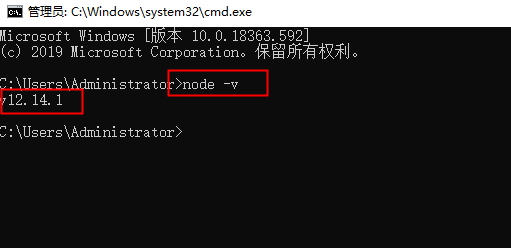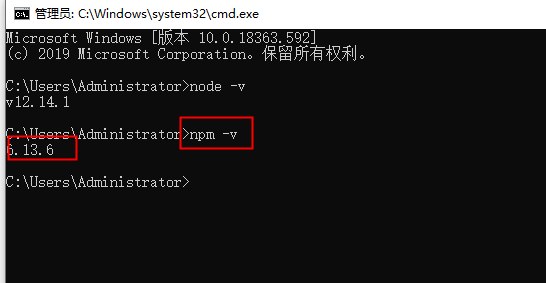1. 第一节安装及创建项目
1.1 安装nodejs
https://nodejs.org/en/download/ (根据自己的电脑系统选择下载版本)
下载完成点击【Next】一直到【install】
node -v 查看是否安装完成
>> v12.14.1 表示安装成功

npm -v 查看npm是否安装成功
>> 6.13.6 表示安装成功

1.2 安装vue脚手架
npm install -g @vue/cli (等待安装完成)
vue -V 查看版本
>> @vue/cli 4.1.2 表示安装成功

1.3 安装淘宝镜像cnpm
npm install -g cnpm --registry=https://registry.npm.taobao.org
cnpm -v
>> cnpm@6.1.1 (C:UsersAdministratorAppDataRoaming
pm
ode_modulescnpmlibparse_argv.js)
>> npm@6.13.6 (C:UsersAdministratorAppDataRoaming
pm
ode_modulescnpm
ode_modules
pmlib
pm.js)
>> node@12.14.1 (D:huanjing
odejs
ode.exe)
>> npminstall@3.27.0 (C:UsersAdministratorAppDataRoaming
pm
ode_modulescnpm
ode_modules
pminstalllibindex.js)
>> prefix=C:UsersAdministratorAppDataRoaming
pm
>> win32 x64 10.0.18363
>> registry=https://r.npm.taobao.org

1.4 建立项目仓库(Github|Coding)
(1) Github: http://www.github.com/
(2) Coding: https://coding.net/
(3) 安装git命令行工具 https://blog.csdn.net/qq_32786873/article/details/80570783
1.5 GIT 常用命令
(1) 拷贝项目:git clone <仓库地址>
(2) 创建分支:git branch <name>
(3) 创建并进入分支:git checkout -b <name>
(4) 切分支:git checkout <name>
(4) 查看状态:git status
(5) 添加所有文件:git add
(6) 提交:git comment -m <当前提交的描述>
(7) 拉取:git pull
(8) 推送:git push
git push --set-upstream origin dev
(9) 查看分支 git branch --list
(10) 查看分支(包含远程分支):git branch -a
(11) git clone git@github.com:XXXXXX/XXXX.git
***
问题 :git@github.com: Permission denied (publickey).
解决 :
ssh-keygen -t rsa -C "你的邮箱名"
生成秘钥文件
***
1.6 创建项目
(1) vue create vue-admin
(2) 选第一个 回车
(3) 选第二个 回车
(4) 选[1,4,5,6,7] 回车
(5) Y表示路由以后会带# ,N表示路由路由以后不带# (http://www.abc.com/#/hello)
(6) 选第二个
(7) 选第四个
(8) 选第一个
(9) n
1.7 启动项目
cd vue-admin
npm run serve

大功告成!!!
2. 第二节(vue.config.js,全局配置,elementui组件)
2.1 创建配置文件
(1) 在项目根目录创建 vue.congig.js 文件
配置手册 :https://cli.vuejs.org/zh/config/#css-extract
(2) 创建normalize.scss
(3) 安装 element 组件
npm i element-ui -S
(4) 导入组件
在根目录下的 main.js 中写入以下内容:
import Vue from "vue";
import App from "./App.vue";
import router from "./router";
import store from "./store";
// 新增
import ElementUI from 'element-ui';
import 'element-ui/lib/theme-chalk/index.css';
Vue.use(ElementUI);
Vue.config.productionTip = false;
new Vue({
router,
store,
render: h => h(App)
}).$mount("#app");
(5) 配置全局样式
在根目录下的 vue.config.js 中写入以下内容:
module.exports = {
/* 部署生产环境和开发环境下的URL:可对当前环境进行区分, baseUrl 从 Vue CLI 3.3 起已弃用,要使用publicPath */
/* baseUrl: process.env.NODE_ENV === 'production' ? './' : '/' */
publicPath: process.env.NODE_ENV === 'production' ? '/public/' : './',
/* 输出文件目录:在npm run build时,生成文件的目录名称 */
outputDir: 'dist',
/* 放置生成的静态资源 (js、css、img、fonts) 的 (相对于 outputDir 的) 目录 */
assetsDir: "assets",
/* 是否在构建生产包时生成 sourceMap 文件,false将提高构建速度 */
productionSourceMap: false,
/* 默认情况下,生成的静态资源在它们的文件名中包含了 hash 以便更好的控制缓存,你可以通过将这个选项设为 false 来关闭文件名哈希。(false的时候就是让原来的文件名不改变) */
filenameHashing: false,
/* 代码保存时进行eslint检测 */
lintOnSave: true,
/* webpack-dev-server 相关配置 */
devServer: {
/* 自动打开浏览器 */
open: false,
/* 设置为0.0.0.0则所有的地址均能访问 */
host: '0.0.0.0',
port: 8080,
https: false,
hotOnly: false,
},
// 配置样式
css: {
loaderOptions: {
sass: {
prependData: `@import "~@/styles/main.scss";`
}
}
}
}
2.2 路由
(1) 重定向路由
redirect: "login"
(2) 路由配置
在 src/router/index.js 中写入以下内容:
import Vue from "vue";
import VueRouter from "vue-router";
Vue.use(VueRouter);
const routes = [
{
path: "/",
redirect: "login"
},
{
path: "/login",
name: "login",
component: () => import("../views/pages/Login.vue")
}
];
const router = new VueRouter({
routes
});
export default router;
3. 第三节(vue文件标准结构,v-for遍历,key,v-binb属性,@click属性,绑定class,基础数据类型,引用数据类型区别)
3.1 vue 文件标准结构
(1) 固定的3块内容:
template,script,style
(2) template
必须有一层父元素,否则会报错,元素不一定是div标签,其他的也可以
(3) script
<script>
export default {
name: "login", // 当前元素名称
components: {}, // 组件,有引入组件时,放置组件名称,
data() { // 数据,v-model绑定数据使用
return {};
},
created() {}, // 创建完成时(生命周期其中一个)
mounted() {}, // 挂载完成时(生命周期其中一个)
methods: {}, // 定义函数
props: {}, // 子组件接收父组件参数
watch: {} // 子组件接收父组件参数
};
</script>
(4) style
<style lang="scss" scoped>
</style>
lang="scss" // 定义类型
scoped // 局部,定义时:只有当前文件应用样式,否则为全局样式
3.2 v-for遍历
(1) 用法:
基于源数据多次渲染元素或模板块。此指令之值,必须使用特定语法 alias in expression ,为当前遍历的元素提供别名:
<div v-for="item in items">
{{ item.text }}
</div>
另外也可以为数组索引指定别名 (或者用于对象的键):
<div v-for="(item, index) in items"></div>
<div v-for="(val, key) in object"></div>
<div v-for="(val, name, index) in object"></div>
v-for 的默认行为会尝试原地修改元素而不是移动它们。要强制其重新排序元素,你需要用特殊属性 key 来提供一个排序提示:
<div v-for="item in items" :key="item.id">
{{ item.text }}
</div>
(2) v-for(简单理解就是数据循环)基于源数据多次渲染元素或模板块。
基础模式:
<template>
<ul id="demo">
<li v-for="item in items" :key="itme.id">
{{ item.message }}
</li>
</ul>
<template>
<script>
var example1 = new Vue({
el: '#demo',
data: {
items: [
{ message: 'Foo' },
{ message: 'Bar' }
]
}
})
<script>
带索引:
<template>
<ul id="demo">
<li v-for="(item,index) in items" :key="itme.id">
{{ item.message }}{{ index }}
</li>
</ul>
<template>
<script>
var example1 = new Vue({
el: '#demo',
data: {
items: [
{ message: 'Foo' },
{ message: 'Bar' }
]
}
})
<script>
(3) 实例
我们可以用 v-for 指令基于一个数组来渲染一个列表。v-for 指令需要使用 item in items 形式的特殊语法,其中 items 是源数据数组,而 item 则是被迭代的数组元素的别名。
<template>
<ul id="example-1">
<li v-for="item in items">
{{ item.message }}
</li>
</ul>
<template>
<script>
var example1 = new Vue({
el: '#example-1',
data: {
items: [
{ message: 'Foo' },
{ message: 'Bar' }
]
}
})
<script>
3.3 v-bind绑定属性
(1) 绑定方式
v-bind:class 或:class
(2) :class的几种绑定方式
最简单的绑定
:class="{ 'active': isActive }"
Test.vue(文件)
<template>
<div id="app">
<ul class="demo">
<li :class="{ 'active': isActive }" v-for="(item,index) in itmes" :key="item.id">{{ item.message }}索引:{{ index }}</li>
</ul>
</div>
</template>
<script>
export default {
name: "demo",
data() {
// 数据,v-model绑定数据使用
return {
itmes: [{
message: '列表选项(1)'
},
{
message: '列表选项(2)'
},
{
message: '列表选项(3)'
},
{
message: '列表选项(4)'
},
],
isActive: false,
};
},
};
</script>
<style lang="scss">
.demo {
text-align: center;
li {
150px;
line-height: 36px;
font-size: 14px;
color: #000;
border-radius: 2px;
cursor: pointer;
}
.active {
background-color: midnightblue;
}
}
</style>
判断是否绑定一个active
:class="{ active: isActive == 10 }"
:class="{ active: isActive == index }"
<template>
<div id="app">
<ul class="demo">
<li :class="{ 'active': isActive==index }" v-for="(item,index) in itmes" :key="item.id">{{ item.message }}索引:{{ index }}</li>
</ul>
</div>
</template>
<script>
export default {
name: "demo",
data() {
// 数据,v-model绑定数据使用
return {
itmes: [{
message: '列表选项(1)'
},
{
message: '列表选项(2)'
},
{
message: '列表选项(3)'
}],
isActive: 2,
};
},
};
</script>
<style lang="scss">
.demo {
text-align: center;
li {
150px;
line-height: 36px;
font-size: 14px;
color: #000;
border-radius: 2px;
cursor: pointer;
}
.active {
background-color: red;
}
}
</style>
3.4 基础数据类型
(1) 基本数据类型(按值访问):
ndefined,Null,Boolean,Number,String
概述
基本数据类型复制:复制的是该变量的副本,这两个变量可以参与任何操作而不相互影响
let a = 11;
let b = a;
b = 22;
console.log(`b:${b}`); // 22 注意这里的单引号
console.log(`a:${a}`); // 11 注意这里的单引号
<script>
export default {
// 当前元素名称
name: "login",
// 组件,有引入组件时,放置组件名称,
components: {},
// 数据,v-model绑定数据使用
data() {
return {
menuTab: [{
text: '登录',
status: true
},
{
text: '注册',
status: false
}],
isActive: false,
};
},
// 创建完成时(生命周期其中一个)
created() {},
// 挂载完成时(生命周期其中一个)
mounted() {
let a = 11;
let b = a;
b = 22;
console.log(`b:${b}`); // 22
console.log(`a:${a}`); // 11
},
// 定义函数
methods: {
// 数据驱动视图进行渲染
// js操作DOM元素
togglenMneu(data) {
console.log(data);
}
},
props: {}, // 子组件接收父组件参数
watch: {} // 子组件接收父组件参数
};
</script>
(2) 引用数据类型(按引用访问):
object,Array,function
概述
引用数据类型复制:复制的是该变量的指针,该指针指向存储在堆中的一个对象。复制操作结束后,两个变量实际上将引用同一个对象。因此,改变其中一个变量,就会影响另一个变量
let aArr = [11,22]; // [11,22]就是 object
let bArr = aArr;
let cArr = bArr;
cArr[0] = 33; // 直接修改了[11,22]对象
console.log(`aArr:${aArr}`); // aArr:33,22 注意这里的单引号
console.log(`bArr:${bArr}`); // bArr:33,22 注意这里的单引号
console.log(`cArr:${cArr}`); // cArr:33,22 注意这里的单引号
<script>
export default {
// 当前元素名称
name: "login",
// 组件,有引入组件时,放置组件名称,
components: {},
// 数据,v-model绑定数据使用
data() {
return {
menuTab: [{
text: '登录',
status: true
},
{
text: '注册',
status: false
}],
isActive: false,
};
},
// 创建完成时(生命周期其中一个)
created() {},
// 挂载完成时(生命周期其中一个)
mounted() {
let aArr = [11, 22];
let bArr = aArr;
let cArr = bArr;
cArr[0] = 33;
console.log(`aArr:${aArr}`); // 11 注意这里的单引号
console.log(`bArr:${bArr}`); // 11 注意这里的单引号
console.log(`cArr:${cArr}`); // 11 注意这里的单引号
},
// 定义函数
methods: {
// 数据驱动视图进行渲染
// js操作DOM元素
togglenMneu(data) {
console.log(data);
}
},
props: {}, // 子组件接收父组件参数
watch: {} // 子组件接收父组件参数
};
</script>
4. 第四节 熟悉element-ui 组件,制作表单验证,了解组件用法
4.1 熟悉element-ui
https://element.eleme.cn/#/zh-CN/component/installation
4.2 v-model
表单控件或者组件上创建双向绑定。
input,select,textarea,component
4.3 form表单实例
<template>
<div id="login">
<div class="login-wrap">
<ul class="menu-tab">
<li v-for="(item,index) in menuTab" :key="item.id" :class="{'current':item.status}" @click="togglenMneu(item)">{{ item.text }}</li>
</ul>
<!--表单 start-->
<el-form :model="ruleForm" status-icon :rules="rules" ref="ruleForm" class="login-form" size="medium ">
<el-form-item prop="mailbox" class="itme-form">
<lable>邮箱</lable>
<el-input type="text" v-model="ruleForm.mailbox" autocomplete="off"></el-input>
</el-form-item>
<el-form-item prop="password" class="itme-form">
<lable>密码</lable>
<el-input type="text" v-model="ruleForm.password" autocomplete="off" minlength="8" maxlength="20"></el-input>
</el-form-item>
<el-form-item prop="code" class="itme-form">
<lable>验证码</lable>
<el-row :gutter="11">
<el-col :span="15">
<el-input v-model.number="ruleForm.code" minlength="6" maxlength="6"></el-input>
</el-col>
<el-col :span="9">
<el-button type="success" class="block">获取验证码</el-button>
</el-col>
</el-row>
</el-form-item>
<el-form-item>
<el-button type="danger" @click="submitForm('ruleForm')" class="login-btn block">提交</el-button>
</el-form-item>
</el-form>
<!--表单 end-->
</div>
</div>
</template>
<script>
export default {
// 当前元素名称
name: "login",
// 组件,有引入组件时,放置组件名称,
components: {},
// 数据,v-model绑定数据使用
data() {
// 验证验证码
var checkCode = (rule, value, callback) => {
let reg = /^[a-z0-9]{6}$/;
if (value === '') {
return callback(new Error('验证码不能为空'));
} else if (!reg.test(value)) {
return callback(new Error('验证码格式错误'));
} else {
callback();
}
};
// 验证邮箱是否合法
var validateMailbox = (rule, value, callback) => {
let reg = /^([a-zA-Z]|[0-9])(w|-)+@[a-zA-Z0-9]+.([a-zA-Z]{2,4})$/;
if (value === '') {
callback(new Error('请输入邮箱'));
} else if (!reg.test(value)) {
callback(new Error('邮箱格式错误'));
} else {
callback();
}
};
var validatePassword = (rule, value, callback) => {
let reg = /^(?!D+$)(?![^a-zA-Z]+$)S{8,20}$/;
if (value === '') {
callback(new Error('请输入密码'));
} else if (!reg.test(value)) {
console.log(value);
callback(new Error('密码应为8-20位的数字加字母'));
} else {
callback();
}
};
return {
menuTab: [{
text: '登录',
status: true
},
{
text: '注册',
status: false
},
],
ruleForm: {
mailbox: '',
password: '',
code: ''
},
rules: {
mailbox: [{
validator: validateMailbox,
trigger: 'blur'
}],
password: [{
validator: validatePassword,
trigger: 'blur'
}],
code: [{
validator: checkCode,
trigger: 'blur'
}]
}
};
},
// 创建完成时(生命周期其中一个)
created() {},
// 挂载完成时(生命周期其中一个)
mounted() {
let aArr = [11, 22];
let bArr = aArr;
let cArr = bArr;
cArr[0] = 33;
console.log(`aArr:${aArr}`); // 11 注意这里的单引号
console.log(`bArr:${bArr}`); // 11 注意这里的单引号
console.log(`cArr:${cArr}`); // 11 注意这里的单引号
},
// 定义函数
methods: {
// 数据驱动视图进行渲染
// js操作DOM元素
togglenMneu(data) {
this.menuTab.forEach(elem => {
elem.status = false
});
data.status = true;
},
submitForm(formName) {
this.$refs[formName].validate((valid) => {
if (valid) {
alert('submit!');
} else {
console.log('error submit!!');
return false;
}
});
}
},
props: {}, // 子组件接收父组件参数
watch: {} // 子组件接收父组件参数
};
</script>
<style lang="scss">
#login {
height: 100vh;
background-color: #344a5f;
}
.login-wrap {
330px;
margin: auto;
}
.menu-tab {
text-align: center;
li {
display: inline-block;
88px;
line-height: 36px;
font-size: 14px;
color: #fff;
border-radius: 2px;
cursor: pointer;
}
.current {
background-color: midnightblue;
}
}
.login-form {
margin-top: 29px;
lable {
display: block;
font-size: 14px;
color: #fff;
margin-bottom: 3px;
}
.itme-form {
margin-bottom: 13px;
}
.block {
display: block;
100%;
}
.login-btn {
margin-top: 19px;
}
}
</style>
**************************************** 未完待续 ***********************************